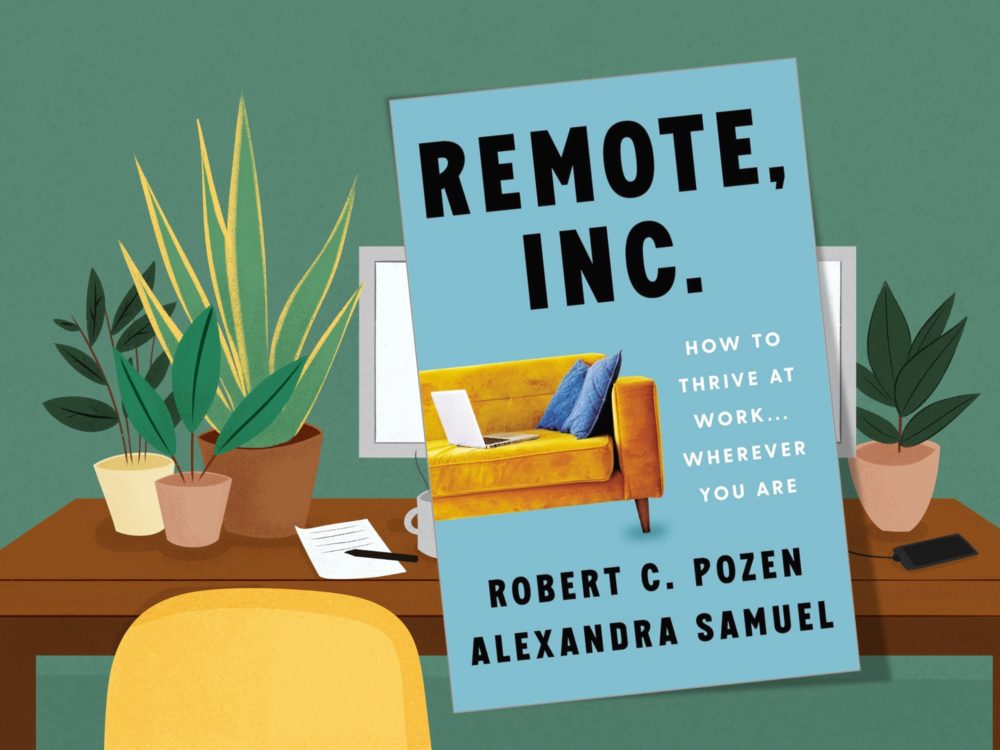Overview
“Remote, Inc.: How to Thrive at Work…Wherever You Are” by Robert C. Pozen and Alexandra Samuel is a guide for adapting to the remote work environment. The book emphasises the importance of shifting one’s mindset from a traditional office-based work structure to thinking like a “Business of One.” This approach encourages individuals to focus on objectives and outcomes rather than hours worked, fostering autonomy and a better work-life balance. The authors provide practical advice on managing schedules, optimising technology for communication and productivity, and reorganising office habits to fit a remote working model.
The book was written in the context of the COVID-19 pandemic, which forced a rapid and widespread shift to teleworking. This unprecedented situation highlighted the need for strategies to effectively work from home, as businesses and employees sought to maintain productivity while navigating the challenges of remote work. Pozen and Samuel’s insights are particularly relevant as they address the unique circumstances brought about by the pandemic, such as the need for clear communication, trust-building in virtual teams, and the management of work-life boundaries. They discuss the broader implications of teleworking, including its impact on corporate culture and the potential for a more flexible, results-oriented work environment.
The authors argue that adopting a teleworking model can benefit both employees and corporations by enhancing productivity, reducing overhead costs, and providing flexibility. They advocate for a shift in corporate culture to embrace the advantages of remote work, which has become an integral part of the business landscape due to the pandemic.
Synopsis
The book is organised in six parts and sixteen chapters. They could be summarised as follows.
The Introduction sets the stage for a transformative approach to remote work. It encourages readers to adopt a new mindset that powers up remote work efficiency and effectiveness. The introduction serves as a guide to quickly grasp the book’s key takeaways, offering specific guidance for common remote work challenges.
Part I: The Business of One dives into the concept of treating oneself as a business entity, focusing on outcomes rather than hours spent working:
- Chapter 1 discusses how to let go of the traditional nine-to-five workday and impress your boss with your remote work productivity, thereby gaining more control over your work life
- Chapter 2 elaborates on setting clear expectations for your work hours and availability, reducing the number of meetings, advocating for remote work to your boss, and creating a personal performance file to track achievements.
- Chapter 3 is about managing a remote team effectively, including establishing success metrics, communication ground rules, using meetings to reinforce company culture, and conducting remote performance reviews.
Part II: Three Key Strategies for Remote Workers of “Remote, Inc.” offers practical strategies to enhance remote work productivity:
- Chapter 4 focuses on the importance of setting clear objectives to drive remote work. It guides readers on how to balance professional and personal priorities, ensuring that daily tasks align with overarching goals. The chapter also advises on allocating time effectively to meet the most critical goals.
- Chapter 5 encourages working backwards from the desired outcomes to increase efficiency. It suggests drafting tentative conclusions to avoid wasted effort and conducting mid-flight reviews to maintain alignment with your boss and team. Additionally, it covers the use of pilot tests to gather feedback from customers and experts.
- Chapter 6 deals with overcoming common remote work challenges such as procrastination. It provides tips on how to focus efforts on high-priority tasks, use multitasking wisely during calls, and respond promptly to important requests.
Part III: Getting Organised as a Remote Worker in “Remote, Inc.” provides guidance on structuring various aspects of remote work life for optimal productivity:
- Chapter 7 offers strategies to manage your schedule effectively. It covers how to avoid the trap of back-to-back meetings, set clear goals for each call or meeting, establish energy-saving routines, and structure eating and exercise habits to support a healthy work-life balance.
- Chapter 8 delves into the technical setup required for efficient remote work. It provides advice on setting up calendars, task lists, and time tracking systems, selecting the right technology and equipment for a home office, choosing appropriate software for different projects, and creating a personalised remote work dashboard.
- Chapter 9 focuses on the physical workspace. It discusses how to share a workspace with family or roommates harmoniously, find new spaces that facilitate productivity, make the most of coworking spaces, and dress appropriately for a home office environment to maintain a professional mindset.
Part IV: Essential Skills for Remote Workers in “Remote, Inc.” equips remote workers with vital skills for productivity and collaboration:
- Chapter 10 teaches how to streamline meetings for remote work. It provides strategies for having fewer and shorter meetings, making online meetings more effective, diplomatically avoiding meetings that don’t add value, and ensuring that every meeting ends with clear next steps.
- Chapter 11 addresses the challenges of staying informed and managing reading material in a remote setting. It offers tips on keeping up with industry news from home, overcoming the drawbacks of reading online, incorporating audio tools to increase reading time, and organising articles and information with a read-it-later file and a clipping file.
- Chapter 12 focuses on enhancing writing skills, crucial for remote communication. It guides on using outlines to prevent writer’s block, collaborating with colleagues to draft documents online, providing and receiving feedback through online platforms, and selecting the most suitable software for writing projects.
Part V: Effective Online Communication in “Remote, Inc.” provides insights into managing digital communication tools efficiently:
- Chapter 13 offers strategies to manage communication channels effectively. It guides on choosing the right mode of communication (email, call, or message), handling email overload through automation, crafting emails that prompt action, and using team messaging platforms to obtain quick responses.
- Chapter 14 focuses on leveraging social media professionally. It discusses building a network of reliable colleagues, avoiding social media distractions, selecting a niche to demonstrate your online expertise, and maintaining an online presence with just three hours of commitment per week.
- Chapter 15 covers the skills needed for compelling online presentations. It includes adapting your speaking style to the digital format, asking the right questions to plan your presentation effectively, creating slide decks suitable for online viewing, and engaging a virtual audience to ensure interactive sessions.
Part VI: Thriving in a World of Remote Work of “Remote, Inc.” is about finding the perfect balance in the remote work environment:
- Chapter 16 discusses creating a balanced schedule that optimises both home and office work. It helps readers identify when they need to spend more time in the office for collaboration and social interaction, and when they need to work from home for focused tasks. The chapter also guides on planning a career that accommodates remote work, ensuring long-term satisfaction and success.
Why you should read?
“Remote, Inc.” is a valuable resource for both employees and employers navigating the post-COVID work environment.
For employees, the book offers a blueprint for maximising productivity and work-life balance in a remote setting. It provides actionable strategies to manage time, technology, and workspace, which are essential for adapting to the flexibility and autonomy that remote work demands. The guide’s emphasis on outcome-based work rather than hours clocked encourages employees to redefine success in terms of achievements, fostering a sense of ownership and satisfaction in their work.
Employers, on the other hand, can benefit from the book’s insights into managing distributed teams and maintaining company culture in a virtual space. The transition to remote work has challenged traditional management practices, and “Remote, Inc.” offers a balanced perspective on how to evolve these practices to fit the new normal. It underscores the importance of trust, clear communication, and defined objectives to ensure team cohesion and efficiency. Although written during COVID times, the book’s principles are enduring, providing a framework for thriving in a work environment that has been irrevocably changed by the pandemic, making it a pertinent guide for the future of work.
Critics and review
The book has been well-received by critics, who praise its timely and practical guidance for remote work. The book’s approach to treating oneself as a “Business of One” and its actionable strategies for productivity and work-life balance have resonated with readers and reviewers alike. Critics highlight the book’s relevance, which has made remote work a necessity for many. The insights provided by Robert C. Pozen and Alexandra Samuel are seen as valuable for both individuals and organisations adapting to the new normal of work.
Critics have also noted the book’s timely publication, coming at a point when remote work has become a staple for many due to the pandemic. The strategies and tips provided by the authors, Robert C. Pozen and Alexandra Samuel, have been praised for their relevance and applicability in a variety of work settings. The book’s advice on creating routines, managing online meetings, and dealing with information overload has been seen as valuable for enhancing productivity and maintaining work-life balance.
Verdict
The book emerges as an indispensable guide in the evolving landscape of work. With its insightful strategies and practical advice, the book serves as a beacon for those seeking to navigate the complexities of remote work with confidence and efficiency. The authors’ expertise shines through in their recommendations, making it a must-read for anyone looking to excel in the remote work environment.
About the authors
Robert C. Pozen is a distinguished figure with a rich background in finance, public policy, and academia. He is the former chairman of MFS Investment Management, the oldest mutual fund company in the United States, and was previously the President of Fidelity Investments.
As an author, he has contributed to the discourse on productivity and financial systems with books like “Extreme Productivity: Boost Your Results, Reduce Your Hours” and “Too Big To Save? How to Fix the US Financial System.”
His academic credentials include a summa cum laude graduation from Harvard University and a J.D. degree from Yale Law School, where he also earned a doctorate for his thesis on state enterprises in Africa. Currently, he is a senior lecturer at MIT Sloan School of Management and a non-resident senior fellow at the Brookings Institution.
Alexandra Samuel is an expert on the digital workplace and a seasoned data journalist. She has previously authored “Work Smarter with Social Media: A Guide to Managing Evernote, Twitter, LinkedIn, and Your Email.” Samuel’s work spans over two decades of experience as a technology researcher and strategist.
She has been a vice president at Vision Critical, a customer intelligence software provider, and the founding director of the Social + Interactive Media Centre at Emily Carr University of Art + Design.
Her academic achievements include a B.A. from Oberlin College and a Ph.D. in Political Science from Harvard University, where her dissertation focused on hacktivism as a form of online political participation. Samuel has contributed to various publications and projects, offering insights into the digital economy and social media’s role in modern communication and business practices.
#telework, #office #work #post-covid #modern #change













